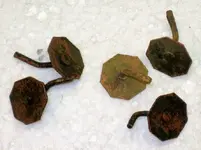James57
Jr. Member
- Joined
- Jan 15, 2006
- Messages
- 62
- Reaction score
- 3
- Golden Thread
- 0
- Detector(s) used
- Minelab Etrac, Detectorpro Headhunter PI
Any idea about these items? I should have put something in for scale, the hexagon part is slightly smaller than a dime. I thought that they were pins of some kind and maybe they had something attached to the hexagon part. I didn't find any trace of anything else with them when I dug them up. I found all of them separately within a 100 ft area in an old park. They seem to be made of copper and they say "CHASE" on the front of the hex part.






